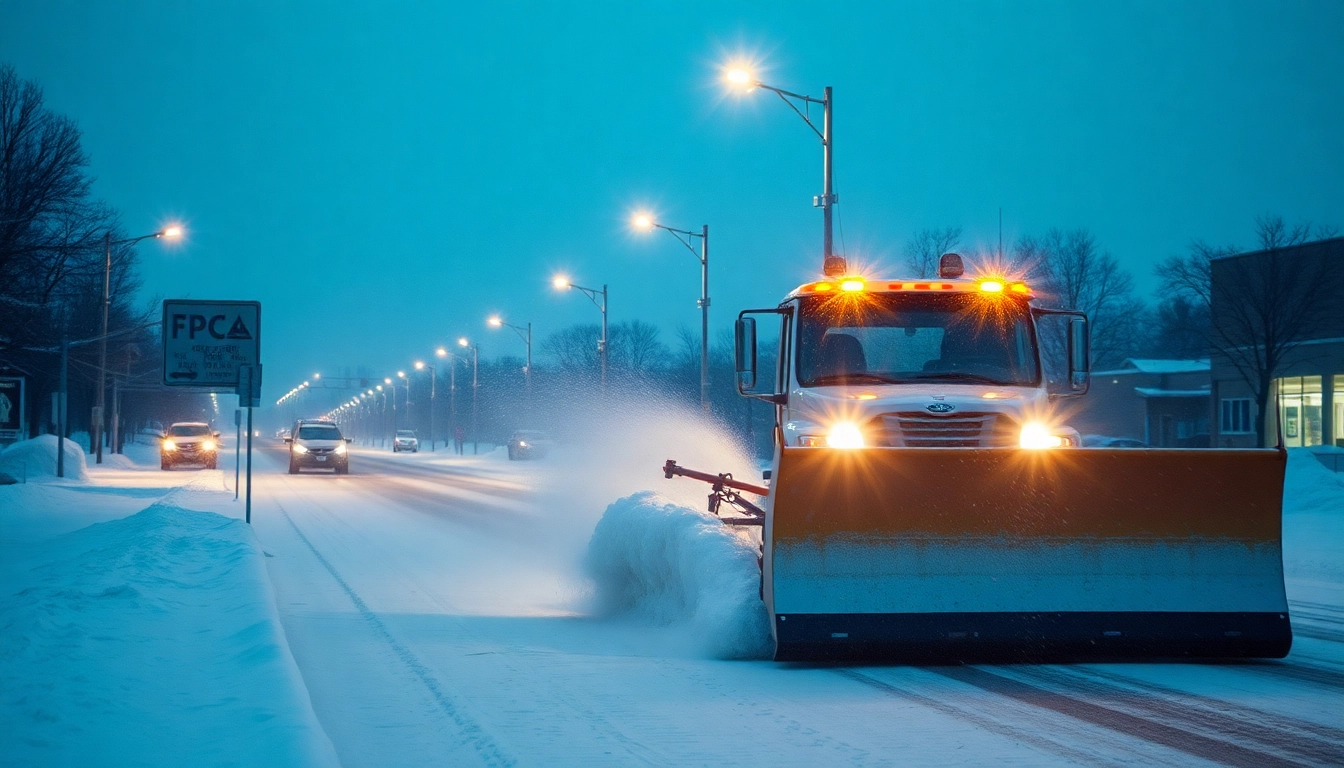Understanding Snow Plowing Basics
What is Snow Plowing?
Snow plowing refers to the practice of clearing snow from areas such as roads, driveways, and public pathways by using specialized vehicles equipped with snow plows. This essential winter maintenance strategy ensures that transportation routes remain accessible and safe during snow events. When snow accumulates, it can create hazardous driving conditions, leading to accidents and inconveniences for residents. However, snow plowing is more than just pushing snow to the side; it’s about facilitating mobility and safety in winter months.
The Importance of Timely Snow Removal
Timely snow removal is crucial for several reasons. First, it enhances public safety by preventing accidents caused by slick, snow-covered surfaces. Second, clearing snow promptly helps reduce the risk of injury for pedestrians navigating sidewalks. Additionally, it minimizes traffic disruptions, allowing emergency services to reach their destinations without delay. Delayed snow removal can exacerbate issues such as compact ice, making subsequent efforts more challenging and resource-intensive.
How Snow Plowing Differs from Snow Removal
While often used interchangeably, snow plowing and snow removal are distinct services. Snow plowing typically involves the act of pushing snow off surfaces to the side, while snow removal encompasses a more comprehensive approach that includes hauling snow away to prevent accumulation. For instance, public snow plowing might involve pushing snow to the roadside, whereas snow removal may require truck transport to a designated location. Understanding these differences is critical for homeowners when considering their options for winter maintenance.
Choosing the Right Equipment for Snow Plowing
Types of Snow Plows and Their Uses
Selecting the appropriate snow plow can significantly impact the efficiency of your snow removal efforts. There are several types of snow plows available, each suited for different situations:
- Straight Blade Plows: These are the most common type and are typically used for residential driveways and smaller areas. They are adjustable, allowing for different angles to push snow effectively.
- V-Plows: Designed to clear deep snow, these plows have a V shape that enables them to cut through and push snow to the sides. They are beneficial for larger commercial properties or heavy snowfall conditions.
- Box Plows: Used mainly in agricultural settings, box plows can lift and carry snow away from the area. They are ideal for dealing with significant snow accumulation and are commonly attached to larger vehicles.
Essential Maintenance Tips for Snow Plowing Equipment
Proper maintenance of snow plowing equipment is critical to ensure optimal performance and longevity. Here are some tips:
- Inspect Before Use: Always check the equipment for wear and tear, including the plow blade, hydraulics, and electrical connections, before the first snowfall.
- Keep It Clean: Regularly clean the plow to prevent rust and buildup of snow and ice, particularly after each use.
- Winterize Your Vehicle: Ensure your plowing vehicle is equipped for winter conditions with antifreeze, good tires, and a functional heating system.
Cost-Effective Solutions for Homeowners
Homeowners often seek cost-effective solutions for snow plowing, especially if they are on a budget. Here are some strategies:
- Invest in a Quality Snow Shovel: For light snowfall, a sturdy snow shovel can be a great investment, allowing for manual removal without hiring professional services.
- Consider a Snow Blower: For larger areas or regular snowfall, a snow blower can save time and labor, paying for itself over the winter season.
- Join a Neighborhood Service: Collaborating with neighbors for shared snow plowing services can reduce individual costs significantly while ensuring timely snow removal.
Snow Plowing Best Practices
Preparing Your Property for Snow Plowing
Preparation plays a significant role in effective snow plowing. Homeowners can take several steps to ensure their property is ready:
- Mark Boundaries: Use stakes or flags to outline the edges of driveways and walkways to keep snow removal services on track, particularly if they are not familiar with your property.
- Clear Obstacles: Remove vehicles, toys, and other obstacles from areas to be plowed to facilitate smoother snow removal.
- Plan for Snow Storage: Identify safe areas to store snow that has been plowed to prevent it from getting in the way of future snow removal efforts.
Strategies for Efficient Snow Plowing
Efficient snow plowing requires strategic planning and execution. Here are some tips:
- Follow a Pattern: Create a systematic plowing route to avoid overlapping areas and ensure every part of your property is covered efficiently.
- Adjust according to Conditions: Snow density can vary; adjusting your plans for heavier snow can save time and decrease the effort needed.
- Use the Right Speed: Snow plows should travel at moderate speeds to ensure thorough clearing without lifting the plow too high off the ground, which can leave snow behind.
Common Mistakes to Avoid During Snow Plowing
Several common mistakes can hinder snow plowing effectiveness. Avoid the following:
- Ignoring Weather Reports: Keeping an eye on forecast conditions helps to anticipate heavy snow and plan accordingly.
- Plowing Too Soon: Attempting to plow before snow stops can lead to missed areas; instead, wait until the snowfall has ended to ensure comprehensive clearing.
- Neglecting the Cleanup: Failing to manage ridges or piles left behind after clearing can lead to congestion and further complications.
Safety Considerations in Snow Plowing
Guidelines for Safe Snow Plowing Operations
Safety is paramount when it comes to snow plowing. Adhering to guidelines can protect you and others:
- Wear Proper Gear: Insulated and waterproof clothing is essential. Using gloves, boots, and hats will keep you warm and comfortable while working.
- Be Aware of Surroundings: Always keep an eye on pedestrians, traffic, and other obstacles to avoid accidents.
- Use Lights: Equip snow plows with flashing lights to increase visibility in low-light conditions.
Protecting Your Property and Infrastructure
Protecting both your property and the infrastructure around you requires careful planning and execution. Strategies include:
- Avoiding Damage to Surfaces: Use plow blades adjusted appropriately to minimize scrape against asphalt or concrete surfaces.
- Preserving Landscaping: Be cautious around trees, shrubs, and gardens; it’s essential not to push snow into delicate areas that could damage roots.
Responding to Winter Weather Conditions
Knowing how to respond to fluctuating winter weather conditions can save time and resources:
- Know When to Act: Identify conditions that require immediate attention, such as severe freezing rain or heavy snow forecasts.
- Adapt Techniques: Employ different techniques based on whether snow is wet and heavy or light and powdery for optimal results.
Future Trends in Snow Plowing Technology
Innovations Shaping the Future of Snow Management
The snow plowing industry is continuously evolving with technological advancements:
- GPS Technology: Enhanced tracking systems enable quicker and more efficient routing for snow plowing services, ensuring prompt response during winter storms.
- Automated Snow Plowing: Innovations in robotics and AI are paving the way for automated snow removal systems, lessening the demand for manual labor.
- Smart Sensors: Advanced sensors can communicate road conditions in real-time, providing data that can help inform plowing schedules more effectively.
Environmental Considerations in Snow Plowing
As sustainability becomes increasingly important, snow plowing practices also need to adapt:
- Eco-Friendly Deicing Agents: Advocating for the use of eco-friendly substances for deicing, reducing the environmental impact of traditional salt and chemicals.
- Recycling Processes: Ensuring that snow disposal methods include recycling efforts when it comes to removing and repurposing snow from urban spaces.
Preparing for Climate Change Impacts on Snow Plowing
Climate change poses new challenges for the snow plowing industry, necessitating preparedness:
- Adapting to Warmer Winters: Snow plowing services must develop strategies to cope with unpredictable and less frequent snowfall.
- Emergency Preparedness: Establishing protocols for quick response during unexpected winter storms is vital, especially with changing weather patterns.


